News & Updates
Surviving Disasters in the Wilderness: Dr. Grant Lipman’s Story

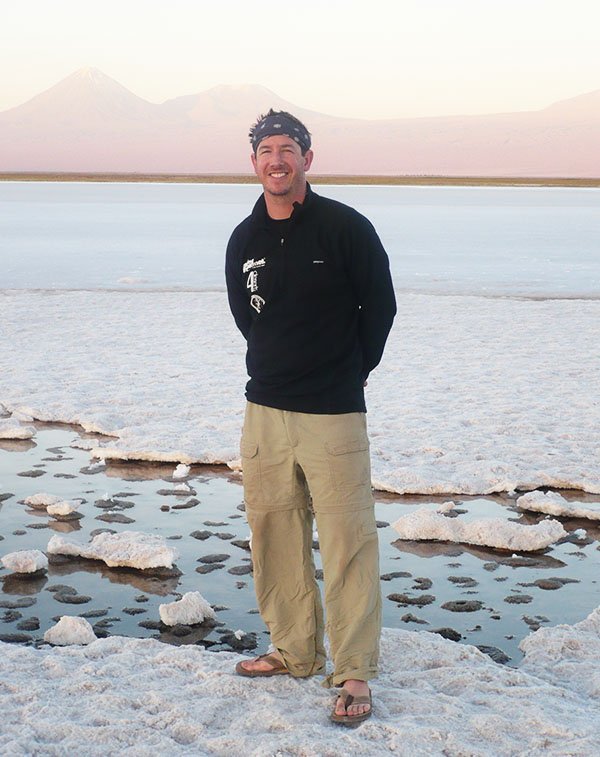
There is a ton of preparation that goes into planning your outdoors trip – booking a reservation, reviewing available programs and activities, packing your gear, double checking the weather, etc.. All of this is made with the assumption that you’ll be able to get there and back again. Well, what about when you can’t?
I have such a story, sadly. Fifteen miles into the Great Smoky Mountains, on my first backpacking trip, my father stepped over a log and right into a hole, tearing ACL, MCL, and PCL. It took the better part of two excruciating days – and a chance encounter with a friendly local – to haul him and our supplies back.
These are the exact scenarios that Dr. Grant Lipman, our guest for this edition of #StoriesByLeaveNoTrace, has spent his career preventing and problem-solving at Stanford’s Wilderness Medicine Fellowship.
That name might look familiar to many of our members – Dr. Grant is the author of The Boy Scouts of America’s Scouting Guide to Wilderness First Aid, a staple of boy scout outings.
In pursuit of helping all of us outdoors folk, and with advances in technology, he now helps run the GOES Health App, the only integrated outdoor medical platform created, staffed and built by the world’s foremost wilderness medicine physicians. For Leave No Trace members, this interview comes with a bonus for you – a free month’s trial of the app.
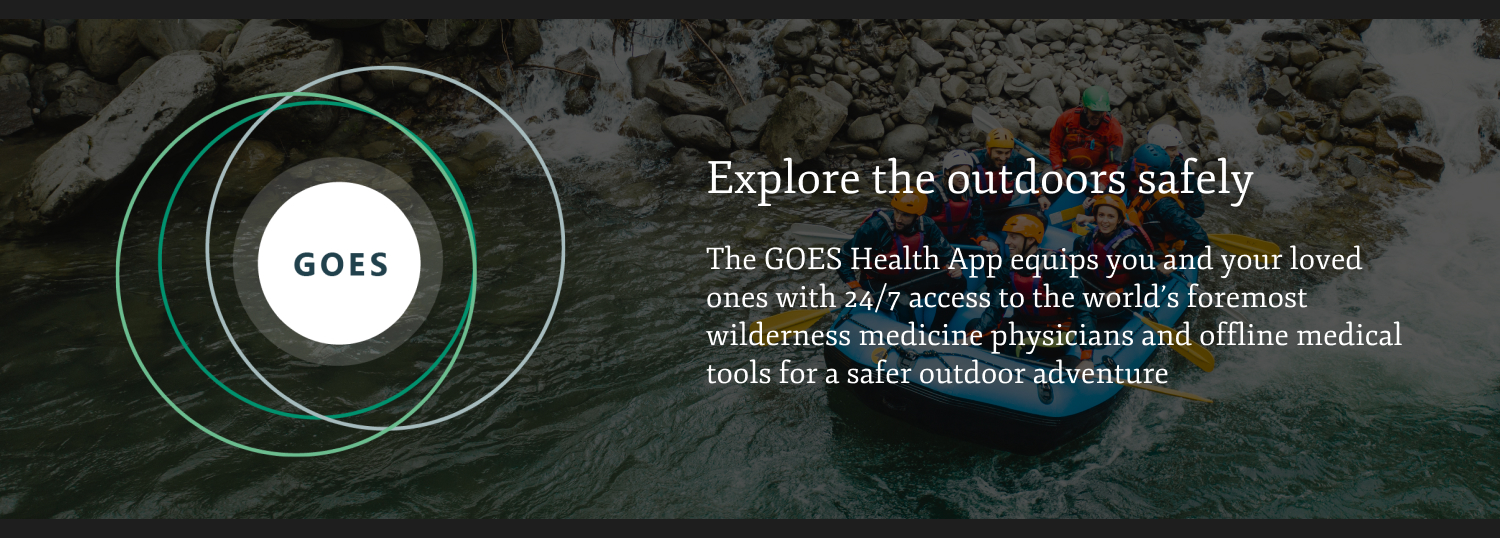
With a long, accomplished career in the growing wilderness medicine field, and a lifetime of living a Leave No Trace ethos, I jumped at the chance to hear more of his story. I hope you’re as enthused by Dr. Grant’s expertise as I am.
Dr. Grant, thank you for your time and for your contributions to the outdoors. Can we actually start with a broad overview of your field? What is wilderness medicine and when does it come into play?
Dr Grant: Wilderness medicine is the prevention, treatment, and understanding of outdoor health emergencies. Our venue is anytime you’re outdoors and away from the infrastructure of traditional medicine. Once you don’t have 911, hospitals, primary care – that’s where wilderness medicine comes in.
However, the definition of wilderness medicine is a moving target these days. I mean, Hurricane Katrina turned the SuperDome in New Orleans into a disaster wilderness area. Climate change is reshaping the field constantly with extreme events. The reality of outdoor health emergencies is becoming more and more salient each day.
My personal appreciation of wilderness medicine has changed over the years, too. It’s not just occurring when climbing 6,000 meter peaks or running ultramarathons… It’s for anyone trying to get out there and have a fun weekend. It’s really about the application of safety.
Like the story you were sharing with me, Michael… when something bad happens, you have to get back.
Yeah, you yourself started in wilderness medicine off the back of a personal experience, correct? Would you mind sharing this origin story?
Dr. Grant: Sure! I grew up in the Pacific Northwest – climbing and skiing volcanoes and all those rocks up in Oregon. I’d never really gotten any injuries. I think when you’re 21, everyone feels invincible.
Then, however, I was backcountry skiing in the Southern Alps of New Zealand for an exchange program. While going down a steep slope, I skied off a cliff and stuck the landing, but the soft snow made my body keep going while my skis stopped.
I shredded and snapped a bunch of ligaments in my knee… and I had to self-evacuate a couple thousand vertical feet away from anyone. My leg kept collapsing on me and it was grueling getting back down. I ended up taking extensive rehab during college to get back to form.
Before that event, I had actually been an art major. But, as my mind was thinking about that experience, this idea of self-preservation kept coming back to me. I was fascinated by the idea of keeping yourself safe. And even more, how do I learn the art and specialty of keeping others safe?
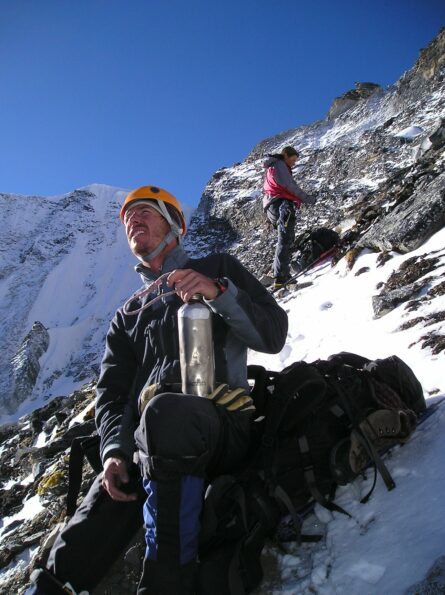
And how did this grow into a career in wilderness medicine?
Dr. Grant: So I ended up training in emergency medicine for a number of years. I’m actually a former professor of emergency medicine at Stanford, where I was a fellow about twenty years ago and then actually ran the wilderness medicine program there for many years.
Wilderness medicine became the application of emergency medicine skills and thinking in an outdoor environment. The skillset of improvisation is key – doing a lot with a little. And not just treating, but preventing these injuries as well.
Unfortunately, bad things happen in beautiful places. Knowing how to prepare and treat those became my world. At the time, Stanford had been the only wilderness medicine fellowship in the nation. Now I think there are about 20.
I’ve really focused my energies on ways to increase access and safety in the outdoors. How do people get a chance to safely explore their chosen environments? How do you get to high altitudes safely? How do you run an ultramarathon? How do you treat blisters? How do you prevent heat stroke?
My perspective has changed from doing these expeditions and getting out there to “how do we expose the masses to these beautiful places safely?” The more of a positive experience folks can have, the more likely people are to continue doing this and bring their family and friends along, promoting the safe access of these outdoors we all love.
My education, research, publishings, and now my work with GOES is all about this, taking this information and putting it in the palm of your hand.
Knee injury notwithstanding, it sounds like you’ve had some awe-filled experiences out in nature, often commingled with your work as a medic. Is there a particular story you care to share?
Dr. Grant: Certainly. The most poignant outdoor experiences have been personal journeys along with things I’ve shared with others. When you’re on your own, you’re really touching into what your own comfort zone is.
Recently, right before the pandemic, I did my first 50-mile ultramarathon up in the Marin Headlands outside of San Francisco. I’d never considered the idea of perpetual motion for twelve hours… the idea of climbing over 10,000 feet, moving through the marine layers of fog coming off the Pacific, and continually moving the whole time.
Sharing that with my friends, sharing that idea that your body can cover this sort of ground, comfortably, was an awe-inspiring appreciation for what human kinetics can do.
We were connected thanks to Leave No Trace’s partnership with the GOES Health App, which helps folks out in the field. Can you share the story behind GOES?
Dr. Grant: This was a culmination of factors. For the last 15 years, people would track me down and send me emails, texts, with all these questions and concerns from all over the world. Like a lot of us in the field, you pick up the phone, you help these people.
Then, in the summer of 2019, the phone rings. It’s a gentleman and his wife I’ve never met, saying he’s been bitten by a rattlesnake. What should they do?
He’d been in the hospital already, and he’d this delayed recurrent envenomation. A severe, rare case of it. I was able to give him some concierge-level care. And I thought about this…
Here is someone that lives in Silicon Valley that has all their resources at their disposal, yet he had to Google my name to get some help with his snakebite. There has to be a way to bring this level of evidence-based science and fact to everyone with all levels of access to resources.
That’s where GOES came from. What started as a seed idea of a bunch of wilderness medicine experts on call was reverse-engineered, it became “how are people getting their information these days?”
We wanted to avoid the Dr. Google phenomenon. We wanted to put out the most accurate, up-to-date information on their phones in a digestible, approachable format.
So GOES stems from a desire to put the best wilderness medicine information in the palm of your hands, even (and especially) when you don’t have access to broadband. Having an offline, clinical decision tool that can walk you through decisions where someone can stay and play, or whether they need to get out.
And then, when you do have connectivity, get in contact with those wilderness medicine professionals. With advances in broadband technology, this is becoming more and more accessible in all areas.
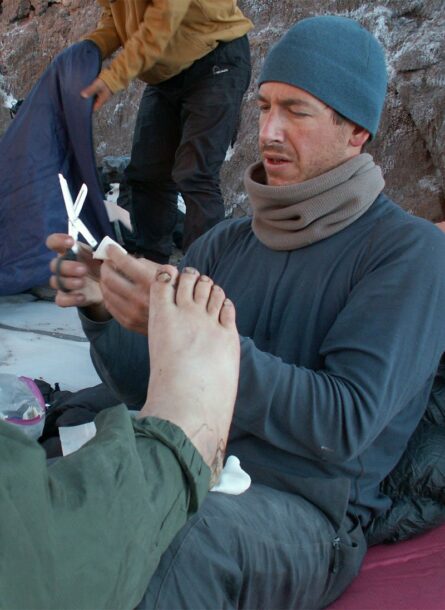
How do you feel that the GOES Health App, and wilderness medicine as a whole, aligns with the ethics of Leave No Trace?
Dr. Grant: The mission of GOES is to promote safe and enjoyable outdoor trips and adventures. And, well, you can’t enjoy the outdoors if the outdoors are being damaged. You don’t have the sanctity of the experience.
This goes beyond large-scale things like climate change. It is also about sheer participation growth. We’re seeing national park visitation rates going up 200%. Everyone is getting out there.
You can’t practice wilderness medicine if there’s not a wilderness.
Is there one little tip or trick that you as a wilderness medicine expert wish all people knew?
Dr. Grant: I’ve got a trick – it’s a small one for blisters. Arguably one of the most common outdoor injuries. Everyone gets them.
We studied paper tape. Basic, little 35-cents-a-roll paper tape. It’s very, very slick and can go anywhere on your feet or body part that might be predisposed to blisters. This cheap little pretaping has been shown to lower blisters by upwards of 40%.
The last question stays the same for everyone. If all of your life experience could be boiled down to one sentence of advice for people, what would you share?
Dr. Grant: I would say pace yourself [laughs]. Life is a marathon, not a sprint, after all.
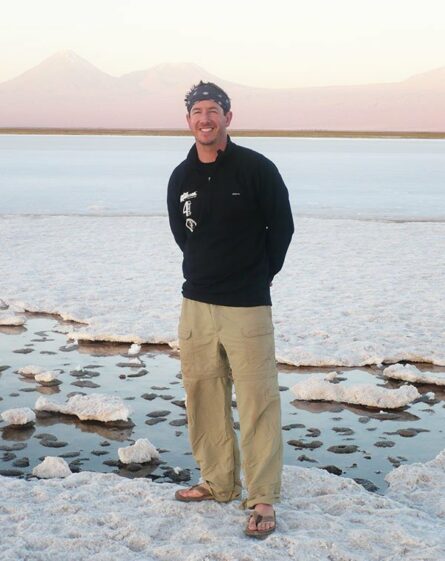
Let’s protect and enjoy our natural world together
Get the latest in Leave No Trace eNews in your inbox so you can stay informed and involved.
